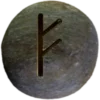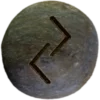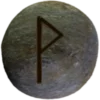Last Updated on February 21, 2025
Table of Contents



Origins and Meaning
The Fehu rune (ᚠ) represents wealth, prosperity, and power. It is pronounced “FAY-hoo” or “FEH-hoo.” The name comes from the Proto-Germanic fehu, meaning “cattle” or “mobile wealth.” Other spellings include “Feh” and “Feoh.” In early societies, cattle symbolized abundance. People measured their status by the number of livestock they owned. It reflects this ancient understanding of prosperity.
Fehu appears in several runestones and inscriptions. The Old English Rune Poem describes it as a source of joy and sorrow. Wealth brings freedom, but it also creates struggles. This duality defines Fehu’s meaning. It represents earned success, but it warns against greed and recklessness.
The rune connects to fire and dynamic energy. Wealth flows like a fire spreading through a forest. It must remain in motion to hold value. Hoarded wealth stagnates, leading to loss. Fehu encourages action, trade, and generosity. Many ancient people used it to bless livestock, crops, and financial dealings. Farmers may have carved it onto barns or fences to ensure prosperity. Merchants could have marked it on goods for good fortune.
The Poetic Edda includes a connection to Fehu through the goddess Freyja. She rules over wealth, fertility, and abundance. Some scholars link it to her brother Freyr, a god of prosperity and kingship. These deities reflect its themes of material success and generosity.
Runestones featuring Fehu often appear in burial mounds. Some warriors received grave goods marked with this rune, symbolizing continued wealth in the afterlife. The Vikings believed material fortune could follow the dead into the next world. This belief suggests its importance in both life and death.
Some myths associate Fehu with the dwarves, the master craftsmen of Norse lore. The Prose Edda describes them creating treasures for the gods, including Odin’s ring Draupnir. This magical ring produces wealth endlessly, much like Fehu’s ideal flow of prosperity. ![]()
The shape resembles two upward horns or branches, symbolizing growth. It encourages ambition, effort, and movement toward success. However, it also reminds people that wealth alone does not bring happiness. True prosperity comes from wise use and sharing.
Runes Associated with Fehu
The Jēra rune (ᛃ), pronounced “YAIR-ah,” connects with Fehu through cycles of growth and harvest. Jēra represents the rewards of hard work. Farmers relied on Jēra to ensure a bountiful harvest, just as it symbolized wealth. The two Elder Futhark runes together reinforce the idea that prosperity comes from patience and effort. ![]()
The Wunjō rune (ᚹ), pronounced “WUN-yoh,” relates to Fehu through joy and fulfillment. Wealth means little without happiness. Wunjō reminds people that true abundance includes friendship, love, and emotional well-being. Together, they suggest a balanced life—both materially and spiritually rich.
Its Importance in Asatru
Fehu represents success through effort. Asatruar value hard work and self-reliance. They believe that effort creates fortune, whether in business, family, or personal growth. Its lessons apply to everyday life. A person must act wisely to maintain their well-being.
Generosity holds great importance in Asatru. Hoarding resources leads to isolation. Sharing creates strong bonds. It reminds Asatruar to give freely, knowing that generosity strengthens the community. This belief extends beyond material wealth. People share wisdom, support, and protection as well.
It also symbolizes new beginnings. Many Asatruar see its influence when starting a venture, moving to a new place, or taking a risk. It encourages them to embrace change with confidence.
Wealth in Asatru includes more than money. Honor, knowledge, and kinship hold great value. Fehu inspires Asatruar to seek balance in all areas of life, ensuring true prosperity.


